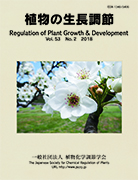Volume 53, Issue 2
Displaying 1-13 of 13 articles from this issue
- |<
- <
- 1
- >
- >|
Feature Articles
-
Article type: Feature Articles
2018Volume 53Issue 2 Pages 91-92
Published: 2018
Released on J-STAGE: December 28, 2018
Download PDF (346K) -
Article type: Feature Articles
2018Volume 53Issue 2 Pages 93-97
Published: 2018
Released on J-STAGE: December 28, 2018
Download PDF (2115K) -
Article type: Feature Articles
2018Volume 53Issue 2 Pages 98-101
Published: 2018
Released on J-STAGE: December 28, 2018
Download PDF (1061K) -
Article type: Feature Articles
2018Volume 53Issue 2 Pages 102-108
Published: 2018
Released on J-STAGE: December 28, 2018
Download PDF (1816K) -
Article type: Feature Articles
2018Volume 53Issue 2 Pages 109-115
Published: 2018
Released on J-STAGE: December 28, 2018
Download PDF (1490K)
Reviews
-
Article type: Reviews
2018Volume 53Issue 2 Pages 116-123
Published: 2018
Released on J-STAGE: December 28, 2018
Download PDF (1587K) -
Article type: Reviews
2018Volume 53Issue 2 Pages 124-130
Published: 2018
Released on J-STAGE: December 28, 2018
Download PDF (2185K) -
Article type: Reviews
2018Volume 53Issue 2 Pages 131-138
Published: 2018
Released on J-STAGE: December 28, 2018
Download PDF (1518K)
Reseach Notes
-
Article type: Research Notes
2018Volume 53Issue 2 Pages 139-145
Published: 2018
Released on J-STAGE: December 28, 2018
Download PDF (1278K) -
Article type: Research Notes
2018Volume 53Issue 2 Pages 146-151
Published: 2018
Released on J-STAGE: December 28, 2018
Download PDF (1578K)
Science Saloon
-
Article type: Science Saloon
2018Volume 53Issue 2 Pages 152-154
Published: 2018
Released on J-STAGE: December 28, 2018
Download PDF (2117K) -
Article type: Science Saloon
2018Volume 53Issue 2 Pages 155-156
Published: 2018
Released on J-STAGE: December 28, 2018
Download PDF (1183K)
News from the office
-
Article type: News from the office
2018Volume 53Issue 2 Pages 157-158
Published: 2018
Released on J-STAGE: December 28, 2018
Download PDF (360K)
- |<
- <
- 1
- >
- >|
